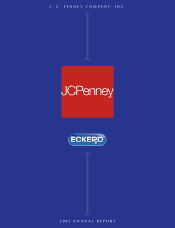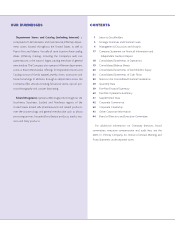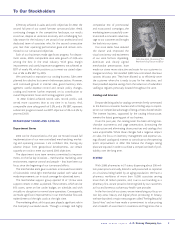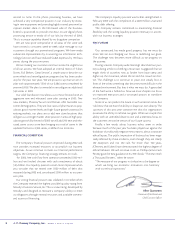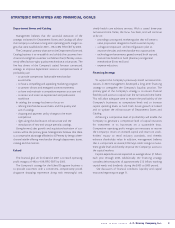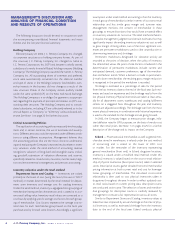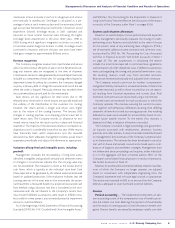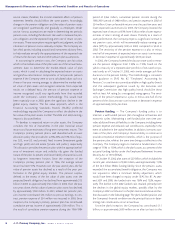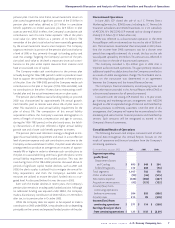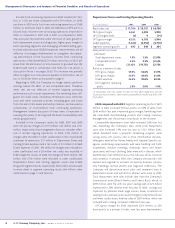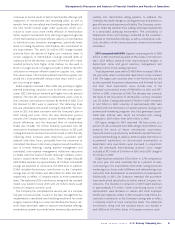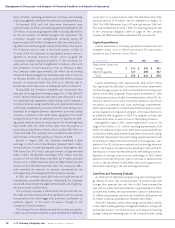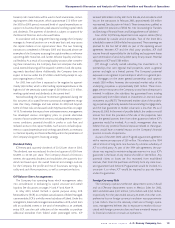JCPenney 2002 Annual Report Download - page 6
Download and view the complete annual report
Please find page 6 of the 2002 JCPenney annual report below. You can navigate through the pages in the report by either clicking on the pages listed below, or by using the keyword search tool below to find specific information within the annual report.
2002 annual report J. C. Penney Company, Inc. 3
Department Stores and Catalog
Management believes that the successful execution of the
strategic initiatives for Department Stores and Catalog will allow
the Company to achieve its long-term operating profit margin tar-
gets that were established in 2001 – 6% to 8% FIFO EBIT by 2005.
The Company’s primary objective in the Department Store and
Catalog business is to re-establish and solidify the customer fran-
chise and strengthen customer confidence that JCPenney consis-
tently offers fashion-right, quality merchandise at value prices. The
five key drivers of the Company’s stated five-year turnaround
strategy to improve department stores to competitive levels of
profitability are:
• to provide competitive, fashionable merchandise
assortments
• to have a compelling and appealing marketing program
• to present vibrant and energized store environments
• to have and maintain a competitive expense structure and
• to attract and retain an experienced and professional
workforce.
In catalog, the strategy has been to focus on:
• refining merchandise assortments and the quality and
size of catalogs
• shipping and payment policy changes to be more
competitive
• right-sizing the distribution infrastructure and the
• introduction of new and unique specialty catalogs.
Going forward, sales growth and acquisition/activation of cus-
tomers will be the primary goals. Management believes that there
is a competitive advantage afforded to JCPenney by being a three-
channel retailer offering merchandise through department stores,
catalog and the internet.
Eckerd
The financial goal set for Eckerd in 2001 is to reach operating
profit margins of 4% to 4.5% FIFO EBIT by 2003.
The Company’s strategy for the Eckerd Drugstore business is
to provide customers with a convenient, competitively priced
drugstore shopping experience along with meaningful and
timely health care advisory services. With a stated three-year
turnaround time frame, the focus has been, and will continue
to be on:
• providing a pricing and marketing plan that will create a
value proposition designed to build customer loyalty
• a drugstore expansion and reconfiguration plan to
improve the sales and merchandise mix opportunities
• technology enhancements geared toward both top and
bottom line benefits in both pharmacy and general
merchandise (front end) and
• expense reduction.
Financing Strategy
To support the Company’s previously stated turnaround ini-
tiatives, in 2001 management developed a long-term financing
strategy to strengthen the Company’s liquidity position. The
primary goal of the Company’s strategy is to ensure financial
flexibility and access to capital over the turnaround time frame.
This will allow adequate time to restore the profitability of the
Company’s businesses to competitive levels and to increase
capital spending levels to fund both future growth at Eckerd
and to update the infrastructure of Department Stores and
Catalog.
Achieving a competitive level of profitability will enable the
Company to generate a competitive level of capital resources
for investment in its businesses on a sustainable basis.
Competitive operating profit margins are necessary to restore
the Company’s return on invested capital and return on stock-
holders’ equity to retail industry standards, and thereby
enhance shareholder value. In addition, management believes
that it is important to restore JCPenney’s credit ratings to invest-
ment grade level and thereby improve the Company’s access to
the capital markets.
Capital expenditures are expected to average about $1 billion
each year through 2005. Additionally, the financing strategy
considers debt maturities of approximately $1.2 billion, working
capital needs and dividends during the 2003 to 2005 period.
See discussion of financial condition, liquidity and capital
resources beginning on page 11.
STRATEGIC INITIATIVES AND FINANCIAL GOALS

